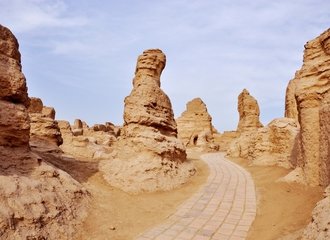Sanxingdui Museum - around Chengdu
In the famous cultural city of Guanghan, on the banks of the Yazi River, lies an influential archeological site named Sanxingdui, whose excavation unveiled the mysterious ancient Shu kingdom and brought a deepened understanding of Sichuan's ancient history and culture. It is the largest and oldest Shu cultural relic in Sichuan and the large number of valuable historical artifacts stored in the Sanxingdui Museum can be called a true wonder of archeological study.
Sanxingdui Site

Legend has it that the Emperor of Heaven cast down three handfuls of earth, which fell near the Jian River and formed three embankments on the Chengdu Plain. The three earthen mounds, described as 'three golden stars in a line', hence became known as Sanxingdui (In Chinese, San means 'three,' xing means 'stars,' and dui indicates an earthen mound), which is where the site's name comes from. According to modern archeologists, the three earth mounds of the Sanxingdui site used to be an earthen rampart that formed the southern wall of an ancient city. Two breaches developed in the city wall and as time passed by, they collapsed and erroded, forming the three mounds we see today.
The Sanxingdui site is located 40 kilometers (24 miles) north of Chengdu city and covers an area of about 12 square km (4.6 square miles). It was first discovered in the spring of 1929, when a farmer discovered a piece of brightly colored jade while digging a ditch. Since then, a total of more than 1,000 artifacts have been unearthed, including more than 400 jade items, a 142 centimeter (56 inch) long and 500-gram (1 lb.) golden staff, a golden bust, a 260-centimeter (102 inches) tall and 180-kilogram (400 lbs.) bronze figure, and a large Yuzhang (a kind of jade adornment worn by a tribal leader, a symbol of power).
Especially impressive is a sizable bronze mask with bulging pupils over 10 centimeters (4 inches) big and two ears spaced 168 centimeters (66 inches) apart, which has established the existence of a "bronze culture" in Chinese archeological history which was previously unknown. The discovery of these cultural relics shows the development from late Neolithic Age (7,000 BC-5,000 BC) all the way to the late Shang (16 to 11 centuries BC) and early Zhou Period (11th century BC - 711 BC).

Some experts believe that the Sanxingdui site indicates a history of more than 3,000 years and might have been the actual capital of ancient Shu. Before its discovery, archeologists considered Shu to be a closed and isolated area with little interaction with cultures on China's Central Plains, the most fertile and developed region in ancient China. However, the cultural relics excavated here shed new light and given rise to new theories of ancient China's cultural landscape, with Sanxingdui as possibly the most representative cradle of Chinese civilization in the upper reaches of the Yangtze River.
The discovery of Sanxingdui's many artifacts has been enlightening, but some cultural relics remain enigmatic. Among the artifacts, some are apotheosized (idolized, elevated to the status of deities) while others are more realistic renderings, some bear a feel of primitive simplicity while others have required much further investigation since archeologists have never seen anything like them before, which also adds to the air of mystery at Sanxingdui and has aroused more interest and curiosity in people from around the world.
Sanxingdui Museum

In order to house and better preserve the precious cultural relics, Sanxingdui Museum was built on the site in 1992. The museum was opened to the public in October 1997, and displayed more than 1,000 cultural relics, among them gold plates, bronzeware, jade articles, pottery, and ivory from the Sanxingdui site and the two sacrificial pits of the Shang Period. It consists of two exhibition halls, the first focusing on a variety of jade articles, gold items and pottery, and the second displays an extensive collection of bronzewares. The two exhibition halls can be further divided into 2 themed areas each, giving a total of 4 exhibits.
Section 1 - Splendor of Ancient Shu Culture
This section is divided into five units. The first unit outlines the history and background of the ancient Shu. The next four units show the skill, imagination, and technical achievements of the Shu people through their handicraft techniques.
Section 2 - Mystery of the Primitive Faith
The exhibition in this section focuses on one topic: humanity and divinity. Models have recreated the life and thinking of Shu culture to give a first-person view to visitors.
Section 3 - Exquisite Cultural Artifacts
Section 4 - Sanxingdui Excavation and Study
This section is a scientific display reflecting Sanxingdui artifacts from all facets, including the impact of the Sanxingdui discovery overseas, the discovery and excavation of the site, and the vital position of Sanxingdui in academic study.
Sanxingdui is the spiritual homeland of Sichuan's ancient Shu people. With numerous cultural relics already excavated and still being discovered, Sanxingdui Museum is an ideal place for you to meet the ancient Shu.
The museum is open from 08:30 to 17:30, and the admission fee is 80RMB per person.





















